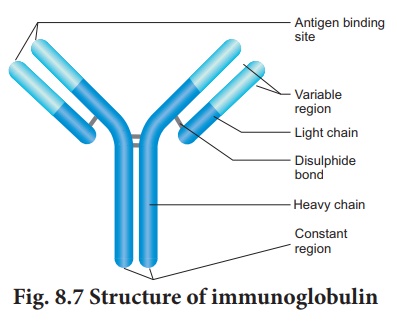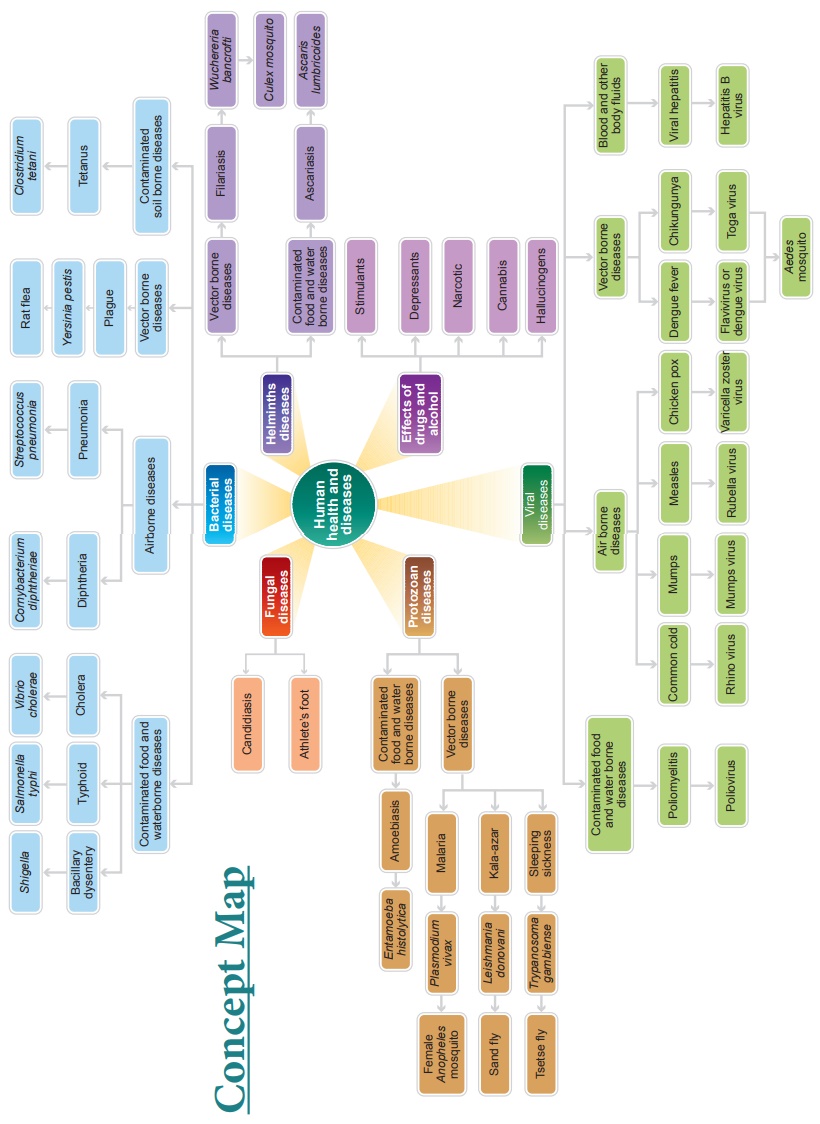Book Back Important Questions Answers | Choose the Correct Answers | Short, brief Answers | Zoology - Human Health and Diseases: Questions and Answers (Evaluation) | 12th Zoology : Chapter 7 : Human Health and Diseases
Chapter: 12th Zoology : Chapter 7 : Human Health and Diseases
Human Health and Diseases: Questions and Answers (Evaluation)
Evaluation
0. Malaria caused by Plasmodium is transmitted through ________
a) Air
b) Contact
c) Fleas on food
d) Mosquito bites
1. A 30 year old woman has bleedy diarrhoea for the past 14 hours, which one of the following organisms is likely to cause this illness?
a) Streptococcus pyogens
b) Clostridium difficile
c) Shigella dysenteriae
d) Salmonella enteritidis
Answer: c) Shigella dysenteriae
0. Which of the following disease is spread through droplet nuclei?
a) Tularemia
b) Listeriosis
c) Chicken pox
d) Mumps
2. Exo-erythrocytic schizogony of Plasmodium takes place in ____________
a) RBC
b) Leucocytes
c) Stomach
d) Liver
Answer: d) Liver
3. The sporozoites of Plasmodium vivax are formed from _________
a) Gametocytes
b) Sporoblasts
c) Oocysts
d) Spores
Answer: c) Oocysts
0. Poliomyelitis which causes infantile paralysis enters the body through _________
a) Skin
b) Mouth and nose
c) Ears
d) Eyes
4. Amphetamines are stimulants of the CNS, whereas barbiturates are ___________
a) CNS stimulant
b) both a and b
c) hallucinogenic
d) CNS depressants
Answer: d) CNS depressants
0. Marijuana is extracted from
a) Dried leaves and flowers of hemp plant.
b) Ergot fungus
c) Roots of hemp plant
d) Cocoa plant
5. Choose the correctly match pair.
a) Amphetamines - Stimulant
b) LSD - Narcotic
c) Heroin - Psychotropic
d) Benzodiazepine - Pain killer
Answer: a) Amphetamines - Stimulant
6. The Athlete’s foot disease in human is caused by ______
a) Bacteria
b) Fungi
c) Virus
d) Protozoan
Answer: b) Fungi
7. Cirrhosis of liver is caused by chronic intake of _____
a) Opium
b) Alcohol
c) Tobacco
d) Cocaine
Answer: b) Alcohol
8. The sporozoite of the malarial parasite is present in ____
a) saliva of infected female Anopheles mosquito.
b) RBC of human suffering from malaria.
c) Spleen of infected humans.
d) Gut of female Anopheles mosquito.
Answer: a) saliva of infected female Anopheles mosquito
0. Haemozoin is
a) A precursor of haemoglobin.
b)A toxin from Streptococcus.
c) A toxin from Plasmodium species.
d) A toxin from Haemophilus species.
0. The drug synthesised from Datura is
a) Hallucinogen
b) Depressant
c) Stimulant
d) Pain killer
9. Where do the following events in the life cycle of Plasmodium takes place?
a) Fertilization - Intestine of Mosquito
b) Development of gametocytes - In human blood
c) Release of sporozoites - From Mosquito Saliva
d) Schizogony - In Human liver cell
10. Paratope is an
a) Antibody binding site on variable regions
b) Antibody binding site on heavy regions
c) Antigen binding site on variable regions
d) Antigen binding site on heavy regions
Answer: c) Antigen binding site on variable regions
11. Allergy involves
a) IgE
b) IgG
c) IgA
d) IgM
Answer: a) IgE
12. Spread of cancerous cells to distant sites is termed as
a) Metastasis
b) Oncogenes
c) Proto-oncogenes
d) Malignant neoplasm
Answer: a) Metastasis
13. AIDS virus has
a) Single stranded RNA
b) Double stranded RNA
c) Single stranded DNA
d) Double stranded DNA
Answer: a) Single stranded RNA
14. B cells that produce and release large amounts of antibody are called
a) Memory cells
b) Basophils
c) Plasma cells
d) killer cells
Answer: c) Plasma cells
15. Given below are some human organs. Identify one primary and one secondary lymphoid organ. Explain its role. Liver, thymus, stomach, thyroid, tonsils
Primary Lymphod organ - Thymus
• They play a vital role in synthesizing of 'T' Lymphocytes.
• This T-Lymphocytes involve in cell mediated Immunity
Secondary Lymphoid Organ - Tonsils
• It helps to fight infections.
• They stop invading germs including bacteria and viruses.
16. Name and explain the type of barriers which involve macrophages.
• The barrier that involve macrophages are phagocytic barrier of Innate immunity.
• Phagocytic barrier just engulf's the pathogenic Organism or its products and digest or neutralise it.
• These macrophages are large irregular shaped cells.
• The monocytes only get converted into macrophages.
• These macrophages are provided with Bacteriolytic enzymes and free radicals, that destroy the pathogen.
17. What are interferons? Mention their role.
• Interferons are the antiviral protein secreted by the virus infected cells.
• Interferon makes the nearby cells resistant to viral infection.
• Interferons are glycoprotein molecules.
• It is secreted by the Leucocytes and Fibroblasts.
18. List out chemical alarm signals produced during inflammation.
The chemical alarm signals produced during inflammation are
• Histamine, Serotonin and prostaglandins.
• These are secreted by the damaged mast cells.
19. Explain the process of replication of retrovirus after it gains entry into the human body.
• The virus enters into macrophages.
• RNA Genome of the Virus replicated to form Viral DNA by the enzyme reverse transcriptase.
• The viral DNA combines with the macrophage.
• The macrophages continue to produce virus.
• Thus the macrophages acts like a HIV factory.
• The progeny viruses released in the blood.
• The progeny virus attack other T-Lymphocytes.
20. Explain the structure of immunoglobulin with suitable diagram.

• The immuglobulin molecule is Y shaped structure.
• It comprises of four polypeptide chains.
• Two-identical Light chains (L) and two identical Heavy chains (H)
• The molecular weight of L chain is 25,000 daltons, with approx 214 amino acids.
• The molecular weight of H chain is 50,000 daltons, with approx 450 amino acids.
• The polypeptide chains are linked together by disulphide (s-s) bonds.
• Each L chain attach to H-chain and two H-chain are attached to each other to form 'Y' shaped structure.
• Each chain has two ends - carboxyl end and amino end.
• The amino end is the variable region.
• The carboxyl end is the constant region
21. What are the cells involved in innate immune system?
• The cells involved in innate immune system are as follows.
a) Leucocytes - Neutrophils and Monocytes.
b) Macrophages.
c) Damaged mast cells.
d) Natural killer cells.
22. What is vaccine? What are its types?
• It is a biological preparation that provides active acquired immunity to a particular disease and resembles a disease causing micro organism.
Types of Vaccine.
• First generation vaccine
a) Live attenuated vaccine use the weakened, aged, less virulent form of the virus -MMR vaccine
b) Killed vaccine - killed or inactivated by heat and other methods - Salk's polio vaccine
c) Toxoid vaccine - contain a toxin or chemical secreted by bacteria or virus DPT
• Second generation vaccine - Contains pure surface antigen of the pathogen - Hepatitis -B vaccine
• Third generation vaccine - Purest and the highest potency vaccine - Recombinant vaccine.
23. A person is infected by HIV. How do you diagnose for AIDS?
Diagnosing Measures for AIDS.
• ELISA - Enzyme Linked Immuno sorbent Assay.
- It is a preliminary Test.
• Western Blot Test - It is the confirmatory test
• IVE -1 - Nucleic acid Test.
• RNA Test - It is expensive.
• Polymerase chain Reaction (PCR) Test - Detect HIV's Genetic material (RNA)
24. Autoimmunity is a misdirected immune response Justify.
• Auto immunity is due to an abnormal immune response.
• Immune system fails to properly distinguish self and non-self antigens.
• Our body produce antibodies and Cytotoxic T cells that destroys our Own tissues.
• It is referred as auto-immune disease.
• Thus auto immunity is a misdirected immune response.
• Auto immune disease is of two types.
(a) Organ- Specific autoimmune disease, (e.g) Addison's disease, Grave's disease.
(b) Non organ specific autoimmune disease, (e.g) Rheumatoid arthiritis, Multiple sclerosis.
25. List the causative agent, mode of transmission and symptoms for Diphtheria and Typhoid.
Diphtheria :
Causative Agent - Cyanobacterium diphtheriae.
Mode of Transmission - Droplet Infection.
Symptoms - Fever, Sorethroat, Hoarseness and difficulty in breathing.
Typhoid :
Causative Agent - Salmonella typhi
Mode of Transmission - Contaminated food and water.
Symptoms - Headache, Fever, Abdominal discomfort and diarrhoea.
26. A patient was hospitalized with fever and chills. Merozoites were observed in her blood. What is your diagnosis?
• If the patient's blood smear test shows the presence of Merozoites the malarial fever is confirmed.
• The symptoms will be shivering, chill, high fever followed by sweating.
• Quinine drugs obtained from bark of chincona tree can be used.
• We can prevent it by
- rearing larvivoral fishes.
- mosquito net and Repellants can be used.
27. i) Write the scientific name of the filarial worm that cause filariasis.
ii) Write the symptoms of filariasis.
iii) How is this disease transmitted?
i) Wuchereria bancrofti is the scientific name of filarial worm. Found in lymph vessels and lymph nodes of man
ii) Worms block the lymphatic system resulting in inflammation of the lymph nodes.
- It causes elephantiasis in Limbs, scrotum and mammary glands.
28. List the common withdrawal symptoms of drugs and alcohol abuse.
• The withdrawal symptoms are
- Mild tremors to convulsions
- Severe agitation and fits.
- Depressed Mood.
- Anxiety.
- Nervousness.
- Restlessness.
- Irritability.
- Insomnia.
- Dryness of throat.
28. Why do you think it is not possible to produce vaccine against common cold?
• There are around 200 types of viruses which causes common cold.
• So, It is difficult to develop vaccine for the causative agent.

Related Topics